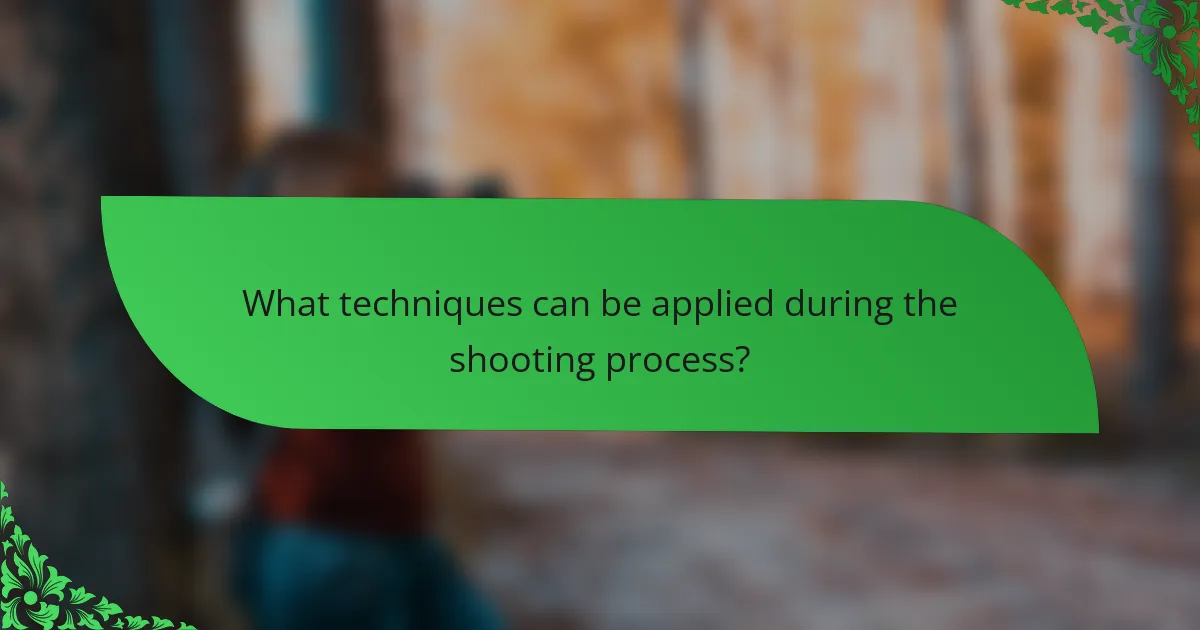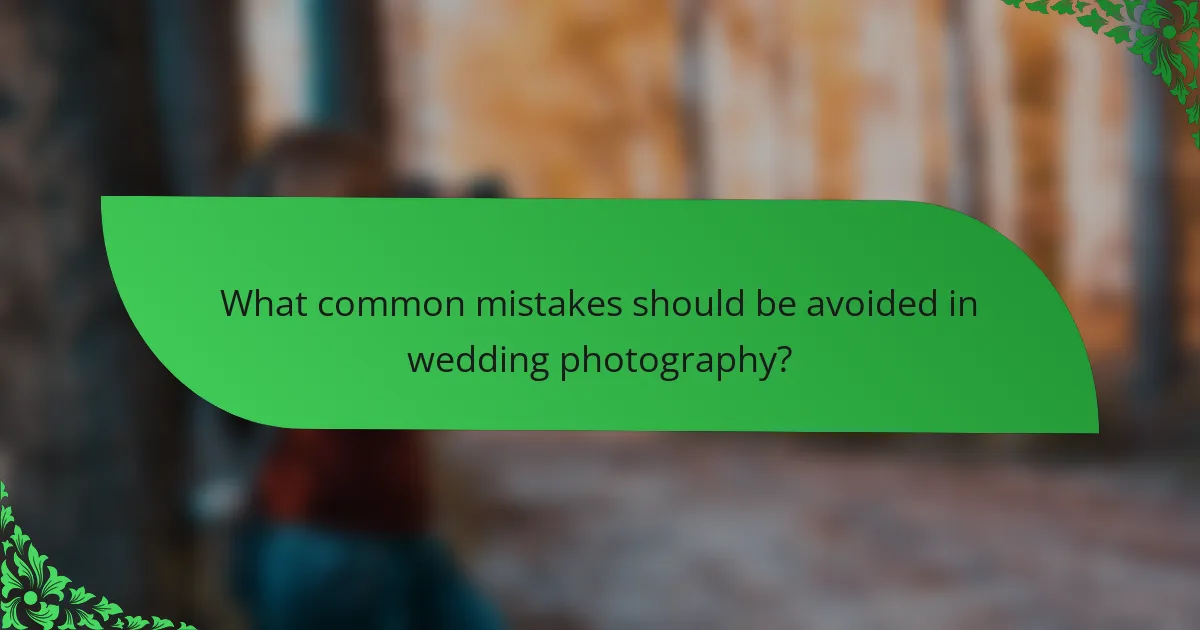Enhancing details in wedding photography is essential for achieving sharp and clear images. Key techniques include the use of prime lenses for superior sharpness, adjusting aperture settings for depth of field, and employing proper lighting to improve clarity, particularly in low-light situations. Additional methods such as using tripods, adjusting shutter speed, and shooting in RAW format contribute to image quality. Common mistakes to avoid include inadequate lighting management, lack of a shot list, and failure to communicate with the couple, all of which can compromise the overall quality of wedding photography. This article provides a comprehensive overview of these techniques and pitfalls, equipping photographers with the knowledge needed to capture stunning wedding images.

What are the key techniques for enhancing details in wedding photography?
Key techniques for enhancing details in wedding photography include using prime lenses, adjusting aperture settings, and employing proper lighting. Prime lenses offer superior sharpness compared to zoom lenses. A wider aperture can create a shallow depth of field, emphasizing the subject while softening the background. Proper lighting enhances clarity and detail, especially in low-light conditions. Using reflectors can illuminate shadows and highlight textures. Additionally, shooting in RAW format preserves image quality for post-processing. Techniques like focus stacking can also enhance detail in complex scenes. These methods collectively improve the overall sharpness and clarity of wedding images.
How do sharpness and clarity impact wedding photography?
Sharpness and clarity are crucial in wedding photography as they significantly enhance image quality. High sharpness ensures that details, such as [censured] expressions and intricate decorations, are well-defined. Clarity improves the overall visibility and contrast in photos, making them more visually appealing. Together, sharpness and clarity contribute to a professional look, which is essential for capturing memorable moments. Research indicates that images with higher sharpness and clarity are more engaging for viewers, leading to a greater emotional impact. Therefore, photographers prioritize these attributes to deliver stunning wedding images.
What are the visual effects of sharp images in wedding photography?
Sharp images in wedding photography create a sense of clarity and detail. They enhance the viewer’s emotional engagement with the moment. Sharpness allows for intricate details, such as lace and floral arrangements, to be captured vividly. This clarity helps to tell a more compelling story through the images. It also draws attention to the subjects, making them stand out against the background. Studies show that sharp images are perceived as more professional and aesthetically pleasing. This perception can significantly impact how couples view their wedding photos. Ultimately, sharp images contribute to a lasting visual memory of the event.
Why is clarity essential for capturing wedding moments?
Clarity is essential for capturing wedding moments because it ensures that every detail is visible and sharp. Clear images allow couples to relive their special day with vivid memories. High clarity highlights emotions, expressions, and intricate details of the event. Research shows that well-defined images enhance viewer engagement and satisfaction. For instance, a study published in the Journal of Visual Communication found that clear visuals significantly improve emotional responses. In wedding photography, clarity contributes to storytelling by capturing fleeting moments accurately. This precision helps preserve the essence of the occasion for future reminiscing.
What equipment is necessary for achieving sharpness and clarity?
A tripod is necessary for achieving sharpness and clarity in photography. It stabilizes the camera, reducing motion blur. A fast lens with a wide aperture enhances light intake and sharpness. High-quality lenses minimize distortion and improve image quality. A camera with a high resolution captures more detail. Additionally, using a remote shutter release prevents camera shake during exposure. Proper lighting equipment, such as external flashes or reflectors, enhances clarity in various conditions. Each of these components contributes significantly to producing sharp and clear images in wedding photography.
Which lenses are best for wedding photography?
The best lenses for wedding photography include prime and zoom lenses. Prime lenses like the 50mm f/1.8 and 85mm f/1.4 are favored for their sharpness and low light performance. Zoom lenses such as the 24-70mm f/2.8 are versatile for various scenes. These lenses allow photographers to capture both wide-angle shots and close-up details effectively. The fast apertures of these lenses enable beautiful background blur, enhancing portrait shots. Additionally, a 70-200mm f/2.8 lens is ideal for candid moments from a distance. This combination of lenses provides flexibility and quality for capturing weddings.
How does camera sensor size affect image sharpness?
Camera sensor size significantly affects image sharpness. Larger sensors typically capture more light and detail. This results in better resolution and sharpness in images. Smaller sensors may struggle with noise and detail retention, especially in low light. Studies show that full-frame sensors outperform crop sensors in sharpness tests. For instance, full-frame cameras can produce images with finer detail due to their larger pixel size. Larger sensors also allow for better depth of field control, enhancing sharpness in selective focus. Therefore, choosing a camera with a larger sensor can lead to sharper images in wedding photography.
What settings should be adjusted to enhance image quality?
To enhance image quality, adjust the camera settings such as aperture, ISO, and shutter speed. A wider aperture (lower f-number) allows more light and creates a shallow depth of field, improving subject focus. Increasing the ISO can help in low-light conditions but may introduce noise, so use it wisely. A faster shutter speed reduces motion blur, ensuring sharp images, especially in dynamic environments like weddings. Additionally, using the correct white balance setting prevents color casts, leading to more accurate colors. These adjustments collectively improve overall image clarity and detail.
How does aperture influence sharpness in wedding photos?
Aperture significantly influences sharpness in wedding photos. A lower f-stop number, such as f/2.8, creates a shallow depth of field. This results in a blurred background, isolating the subject but may reduce overall sharpness. Conversely, a higher f-stop number, like f/8 or f/11, increases depth of field. This enhances sharpness across the entire image, making more elements in focus.
Using a higher aperture setting is beneficial for group shots and landscape backgrounds. It ensures that all subjects remain sharp and clear. Additionally, lenses often have a “sweet spot” aperture where they produce the sharpest images. This is typically between f/5.6 and f/8 for many lenses.
Photographers should consider aperture alongside shutter speed and ISO for optimal exposure. Balancing these settings will enhance sharpness while maintaining proper lighting.
What role does shutter speed play in capturing clear images?
Shutter speed controls the duration of light exposure on the camera sensor. A faster shutter speed reduces motion blur, capturing sharp images of moving subjects. For instance, a shutter speed of 1/500 second freezes action effectively. In contrast, a slower shutter speed may result in blurred images if the subject is in motion. The choice of shutter speed is crucial in wedding photography. It ensures clarity in dynamic moments, like dancing or candid interactions. Properly selecting shutter speed enhances detail and sharpness in the final images.

What techniques can be applied during the shooting process?
Techniques that can be applied during the shooting process include using a tripod, adjusting shutter speed, and selecting appropriate aperture settings. A tripod stabilizes the camera, reducing motion blur. Adjusting shutter speed allows for clearer images in varying light conditions. Selecting a smaller aperture increases depth of field, enhancing sharpness. Additionally, using manual focus can ensure precise focusing on subjects. Employing natural light effectively can also contribute to clarity in photos. Finally, utilizing lens filters can improve contrast and reduce glare.
How can composition improve detail in wedding photography?
Composition enhances detail in wedding photography by guiding the viewer’s eye and creating visual balance. Effective composition uses elements like framing, leading lines, and symmetry to draw attention to key subjects. By arranging elements thoughtfully, photographers can highlight intricate details, such as decorations and expressions. This approach helps to create a narrative, making the photograph more engaging. Research indicates that well-composed images are perceived as more aesthetically pleasing. A study published in the Journal of Visual Communication and Image Representation supports this, showing that composition significantly affects viewer perception of detail and clarity.
What framing techniques enhance the subject’s clarity?
Framing techniques that enhance the subject’s clarity include the use of leading lines, rule of thirds, and depth of field. Leading lines guide the viewer’s eye directly to the subject. This technique creates a visual pathway that emphasizes the focal point. The rule of thirds involves positioning the subject along gridlines to create balance. This method draws attention to the subject while maintaining a pleasing composition. Depth of field controls the focus area, allowing the subject to stand out against a blurred background. This separation enhances the subject’s prominence in the image. Each technique contributes to clearer, more impactful wedding photography.
Why is the use of leading lines important in wedding photography?
The use of leading lines is important in wedding photography because it directs the viewer’s eye toward the main subjects. Leading lines create a sense of depth and perspective in images. They help to frame the couple or key moments within the scene. This technique enhances visual interest and composition. Effective use of leading lines can also evoke emotions and tell a story. For example, a pathway or an archway can guide the viewer’s focus. Research indicates that images with strong compositional elements, like leading lines, are more engaging. Thus, incorporating leading lines can elevate the overall quality of wedding photographs.
What post-processing techniques enhance sharpness and clarity?
Post-processing techniques that enhance sharpness and clarity include sharpening filters, clarity adjustments, and noise reduction. Sharpening filters, like Unsharp Mask or Smart Sharpen, increase edge contrast to make images appear crisper. Clarity adjustments enhance mid-tone contrast, improving overall image definition. Noise reduction techniques, such as applying a noise reduction filter, help maintain sharpness while reducing unwanted grain. These methods collectively improve the visual quality of wedding photographs, making details more pronounced. Studies show that proper sharpening can significantly enhance perceived detail in images, making these techniques essential for professional results.
How can sharpening tools in editing software improve image detail?
Sharpening tools in editing software enhance image detail by increasing the contrast between adjacent pixels. This process makes edges appear more defined and clearer. When sharpening is applied, it emphasizes fine details, improving the overall perceived resolution. The tools work by adjusting pixel values based on their surrounding pixels. This technique can reveal textures and subtle features that may not be visible in the original image. Studies show that proper sharpening can significantly improve the clarity of images, especially in high-resolution formats. Effective sharpening can lead to more visually appealing photographs, particularly in wedding photography where detail is crucial.
What are the best practices for noise reduction in wedding photos?
Use a low ISO setting to minimize noise in wedding photos. Lower ISO values reduce the camera sensor’s sensitivity to light, which decreases graininess. Shoot in well-lit environments to avoid increasing ISO. Utilize noise reduction software during post-processing to further enhance image quality. Apply noise reduction selectively to preserve detail in important areas. Use a tripod to stabilize the camera and allow for longer exposure times without increasing ISO. Consider shooting in RAW format to retain more image data for editing. These practices contribute to clearer, sharper wedding photos.

What common mistakes should be avoided in wedding photography?
Common mistakes to avoid in wedding photography include poor lighting management. Inadequate lighting can lead to blurry or grainy images. Another mistake is not having a shot list. A shot list ensures all important moments are captured. Failing to communicate with the couple can cause missed expectations. Additionally, not checking equipment beforehand can result in technical issues on the day. Overlooking background distractions can detract from the main subjects. Lastly, neglecting to capture candid moments may lead to a lack of emotional depth in the photos. Each of these mistakes can significantly impact the quality of wedding photography.
How can improper focus affect wedding photography outcomes?
Improper focus can significantly detract from wedding photography outcomes. When images are out of focus, key moments may appear blurry or indistinct. This can lead to disappointment for couples who expect sharp, clear memories of their special day. Portraits may fail to capture the emotions of the moment if the subjects are not sharply defined. Group shots can become chaotic and unrecognizable, making it difficult for viewers to identify individuals. Additionally, landscapes and venue shots lose their impact when focus is mismanaged. Photographers need to ensure accurate focus to maintain image quality. Studies show that sharpness is a crucial factor in viewer satisfaction with photographs.
What are the signs of focus issues in wedding images?
Signs of focus issues in wedding images include blurriness, soft edges, and lack of detail. Blurriness occurs when the subject is not sharply defined. Soft edges can indicate that the focus point is misplaced. Lack of detail in important areas suggests improper focus. Out-of-focus backgrounds can also distract from the main subject. Additionally, inconsistent focus across multiple images may indicate a systematic issue. These signs can lead to unsatisfactory results in wedding photography.
How can photographers ensure proper focus during shoots?
Photographers can ensure proper focus during shoots by using manual focus settings and autofocus systems effectively. Manual focus allows for precise adjustments based on the subject’s distance and lighting conditions. Autofocus systems, when used correctly, can quickly lock onto subjects, especially in dynamic environments.
Additionally, selecting the appropriate focus mode is crucial. Single-point autofocus is ideal for stationary subjects, while continuous autofocus is better for moving subjects. Photographers should also consider using a tripod to stabilize the camera, reducing the chance of motion blur.
Using a smaller aperture increases depth of field, helping to keep more of the scene in focus. Regularly checking focus through the camera’s viewfinder or live view screen can help confirm sharpness.
Finally, practicing with different lenses can enhance understanding of focus characteristics. Lenses with faster autofocus motors tend to perform better in challenging conditions.
What challenges do photographers face in maintaining clarity?
Photographers face several challenges in maintaining clarity. One significant challenge is camera shake, which can lead to blurry images. This often occurs when using slow shutter speeds or handheld shooting. Another challenge is lens quality; lower-quality lenses may not produce sharp images. Additionally, focusing errors can result from misalignment or incorrect autofocus settings. Environmental conditions, such as low light or high contrast, can also hinder clarity. Furthermore, post-processing techniques can sometimes degrade image quality if not applied correctly. Lastly, the choice of aperture affects depth of field, impacting overall sharpness in the image.
How does lighting affect clarity in wedding photography?
Lighting significantly impacts clarity in wedding photography. Proper lighting enhances detail and reduces noise in images. Natural light creates soft shadows and highlights, improving overall image quality. Conversely, harsh lighting can cause overexposure and loss of detail. Low light conditions often require higher ISO settings, which can introduce graininess. Using diffused light sources helps maintain clarity by softening shadows. Additionally, the direction of light affects texture and depth, contributing to the perception of clarity. Photographers often adjust their techniques based on lighting conditions to ensure sharp, clear images.
What environmental factors can impact image sharpness?
Environmental factors that can impact image sharpness include lighting conditions, atmospheric haze, and motion. Poor lighting can lead to reduced contrast and detail, making images appear softer. Atmospheric haze, caused by pollution or humidity, can blur distant subjects. Motion blur occurs when the camera or subject moves during exposure, resulting in a lack of sharpness. Additionally, temperature variations can affect lens performance, leading to distortion. These factors can significantly influence the overall clarity of wedding photographs.
What are the best practices for achieving sharpness and clarity?
To achieve sharpness and clarity in wedding photography, use a tripod for stability. A steady base reduces camera shake, enhancing image sharpness. Utilize a fast shutter speed to freeze motion. This is crucial in dynamic wedding environments. Set an appropriate aperture for depth of field. A smaller aperture increases sharpness across the frame. Focus accurately on the subject to ensure clarity. Use manual focus when necessary for precise control. Optimize lighting conditions to avoid noise, which can degrade clarity. Post-processing techniques can also enhance sharpness. Software tools allow for adjustments without losing detail.
How can photographers prepare for different lighting conditions?
Photographers can prepare for different lighting conditions by adjusting their equipment and settings. They should use lenses with wide apertures for low light situations. A tripod can stabilize the camera in dim environments. Photographers must also adjust ISO settings to increase sensitivity to light. In bright conditions, they should use neutral density filters to reduce light entering the lens. Understanding the exposure triangle is crucial for balancing aperture, shutter speed, and ISO. Additionally, practicing with different lighting scenarios enhances adaptability. These methods ensure photographers can capture sharp and clear images regardless of lighting.
What tips can ensure optimal settings for wedding photography?
To ensure optimal settings for wedding photography, use a wide aperture for shallow depth of field. This technique helps to isolate subjects and create a pleasing background blur. Set a fast shutter speed to freeze motion during dynamic moments, such as dancing. A shutter speed of at least 1/200th of a second is recommended for crisp images. Adjust ISO settings based on lighting conditions; use a lower ISO in bright light and a higher ISO in dim settings. This balance prevents noise in images. Utilize natural light whenever possible, as it enhances skin tones and overall image quality. In low-light scenarios, consider using an external flash or a diffuser to soften harsh light. Lastly, always shoot in RAW format to retain maximum detail and flexibility in post-processing.
Enhancing details in wedding photography focuses on techniques for achieving sharpness and clarity in images. Key methods include utilizing prime lenses, adjusting aperture settings, and managing lighting effectively. The article discusses the impact of sharpness and clarity on image quality, essential equipment for optimal results, and the importance of composition and framing techniques. Additionally, it covers post-processing strategies to enhance image detail, common mistakes to avoid, and best practices for capturing clear, engaging photographs in various lighting conditions.



